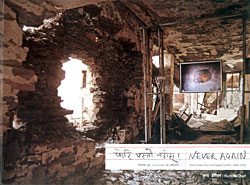 |
Now, nepa-laya has selected some of the tens of thousands of testimonies in a new book, Never Again, which is being launched on Sunday. All the feedback, from the page-long ones to 'Malai naramro lagyo' written by a kindergarden student have the same message: 'never again'.
The testimonies force us to remember the sorrows of war. Nepalis went through a collective catharsis, and these words are the outpourings of our nation's soul. The victims of war saw that there were many more like them, and the exhibition seems to have helped them share the pain. Looking at the pictures together, people, who did not suffer directly, cried with the ones who did.
During the war, we all prayed for peace, for fewer deaths, less destruction. But casualties became statistics, and we soon forgot about the families of the deceased, the disappeared, the injured, and the displaced. The photos in A People War told the stories behind the numbers, which is why they were so powerfully moving.
In the sequel, Never Again, we hear the voices of Nepalis from Mechi to Mahakali, all ages, religious and ethnic groups and through boundaries of literacy. (Illiterate and vision impaired visitors dictated their responses.) Everyone's opinion is equally important: for once, this is history written by the people of what happened to them, not history written by the winners or so-called experts.
Most agree that we should learn lessons and be 'inspired to work towards social transformation and sustainable peace'. Some think violence is sometimes needed for social justice. Baburam Bhattarai writes a dialectic critique of political violence after seeing the exhibition in Gorkha. His comment shows how arrogantly ignorant leaders are about the war they unleashed on the people. Bhattarai's comment will break the hearts of many who expected leaders to understand, but it seems the pictures somehow failed to do so: that we have cried together, and that no matter for what ends, violence is not justifiable.
'What is the price of tears?' writes one viewer. 'History doesn't die,' writes another. The back cover of the book has a poignantly short sentence: 'After the blood come the tears.' Another viewer says 'Show these pictures to Gyanendra, Girija, Prachanda why are you showing it to us?'
The war may be over, but there is no peace yet. For the families of the disappeared, the sorrows continue, the children of the dead suffer hardships. It will take time for people to forgive and start trusting each other. Perhaps because we have been through so much, we want to forget and move on. But we can't forget until we have learnt our lessons.
Never Again helps us remember, and helps the process of reconciliation through justice.
Aditi Adhikari
Never Again will be launched on 14 June after which it will be available at all leading book stores. The documentary Frames of War based on the book will be screened at the Russian Cultural Centre 14-20 June. Admissions free, but bookings must be made in advance through nepa-laya at 9751083433.


